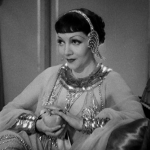 |
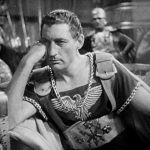 |
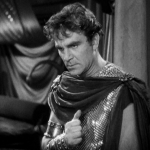 |
| Cleopatra Claudette Colbert |
Julius Caesar Warren William |
Marc Antony Henry Wilcoxon |
| Released by Paramount Pictures | Directed By Cecil B. DeMille |
||
Proof That It’s Pre-Code-ish
- The film’s title card is placed on a strategically lit nude woman.
- Much of Claudette Colbert’s wardrobe is focused on showing as much of her chest region as possible. One outfit is essentially a skirt and pasties!
- And a lot of the extras are somehow wearing even less.
- This film has an almost literal cat fight– women dressed in leopard skins just start going at it.
- Historically, Cleopatra the Egyptian probably wasn’t as lily white as Claudette Colbert. Much of the plot also hinges on just how much the Romans look down on Egyptians, viewing Cleopatra as inferior because of her race.
- Cleopatra slinks off with both Antony and Caesar and there’s no doubt as to what she’s doing with them when the camera pans away. This film might also feature the most over-the-top consummation celebration in cinematic history.
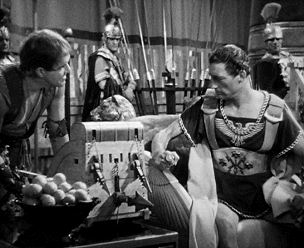
Also never let it be said that DeMille didn’t know when or how to exploit phallic imagery.
Cleopatra: Gold Digger of the Nile
“I’ve seen a god come to life. I’m no longer a queen. I’m a woman.”
I know people who hate remakes. Me? Nah. I indulge in them. Our legends come from being told and told again, and our movies adjust to the times they’re made in. Watch the three versions of King Kong and you’re given three vastly different takes on the same idea, each deeply reflective of the time they were made in– pre-Code, New Hollywood, and the Blockbuster Era.
Now let’s look at a tale that’s been retold since time immemorial. The legend of Egyptian Queen Cleopatra and her doomed romances with Julius Caesar and Marc Antony is one of the major turning points in Western history. Everyone has had a go at the story, from William Shakespeare to The Hallmark Channel. That Cecil B. DeMille, the director for whom the word ‘grandiose’ was considered small potatoes, decided to craft his own take on it should come as no surprise.
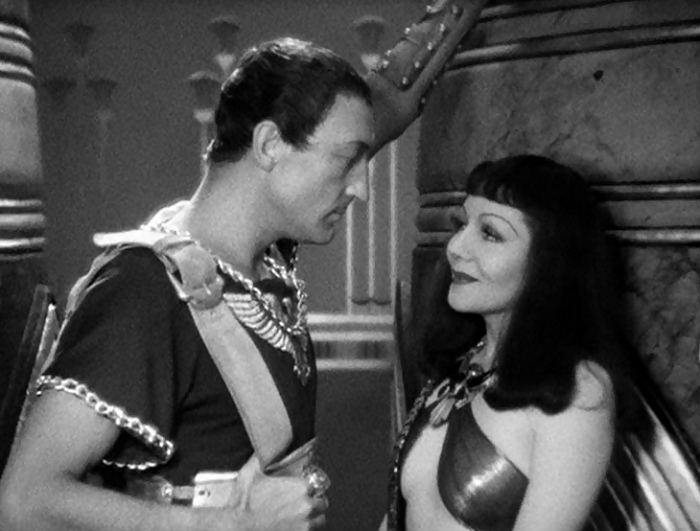
“Hey, baby, come around here often? … oh, you rule this place? Give me all your money.”
Aiming for something a bit more populist and drenching it in sex, Cleopatra is the story of Egypt’s last pharaoh and her desperate attempts to save her country from invasion and destitution– all the while keeping her heart intact. The plot is familiar, but how it’s couched fits in with a lot of 1930s female dramas– hell, Cleopatra even gets the wisecracking blonde best friend! Cleopatra’s fate is tied up in who she can seduce and how. She may as well be the The Gold Digger of 48 BC.
Claudette Colbert plays the titular queen, emphasis on the ‘titular’. (I know that isn’t very classy to say, but look at some of these gowns and disagree!) The film’s opening shot is of a vacant bed, a very sly indicator for the route many of the film’s interactions will be taking. But for now, we’re missing a key participant– Cleopatra has been kidnapped by the Prime Minister of Egypt. Feeling that her presence will usurp negotiations for Roman tribute, they leave her in the desert and point her the way to Syria.
Cleopatra doesn’t take this laying down– actually, she’s tied to a stake at that point, so it would have been difficult to do– and escapes back to Alexandria. She introduces herself to Julius Caesar by tumbling out of a folded up rug. When even this can’t seem to tear his interest away from paperwork and the bureaucracy of domination, she turns to seducing him, first by dreams of conquest, then with herself.
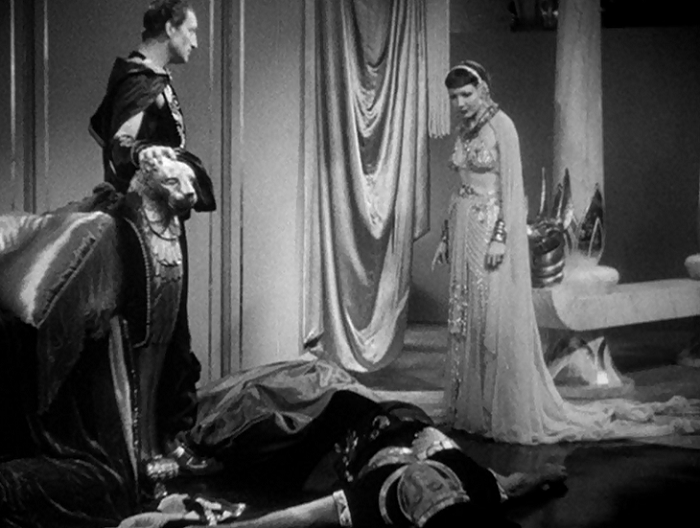
Nothing spells lust like c-o-r-p-s-e.
Pre-Code mainstay Warren William is Julius Caesar, though his portrayal of the great conqueror isn’t exactly aiming for the rafters. William is pretty much replaying his curt boss from Employees Entrance, turning his Caesar into a wry manager whose only pleasures come from power, blood, and making love. When Cleopatra shows him the gateway to all three– by promising him an alliance that could conclude in the conquest of India, punctuated by the quick murder of the traitorous prime minister right in front of him– he may as well start slobbering.
Unfortunately, their lovemaking becomes a steppingstone in his plot to control the world. He brings her back to Rome, intending for the two to marry and solidify their alliance, with his current wife being but a minor inconvenience. The Roman people, while certainly understanding the wonders of infidelity, are aghast at Caesar’s choice in dalliances. As much as his turn towards fascism repulses them, the thought of miscegenation seems to amplify the angry din.
Ignoring the many, many heavy telegraphed signs of his impending doom, William’s Caesar regards everything around him as a speed bump to conquest. His assassination is handled in a wonderfully understated way. As the bevy of knives plunge into him, he seems more annoyed that he’s being waylaid from important business than being brutally murdered. Only the appearance of his friend, Brutus (Arthur Hohl, with his unmistakeable eyes conveying horrific sadness under a glorious beard), breaks him from his trance as the godking of the world back to a small man whose reach has finally exceeded his grasp.
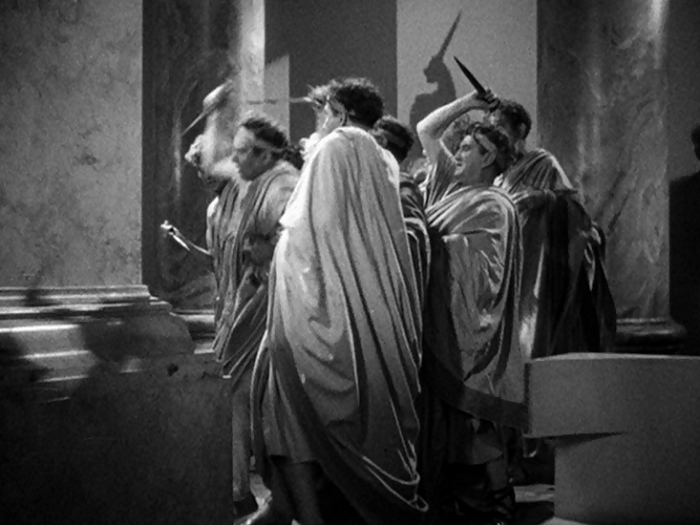
Stabbing party, woooo
I’ve heard William’s portrayal of Caesar called ‘wooden’, but I don’t see it. He’s stiff, but he’s droll as well, happy to watch the machinations of the world work in his favor. But that stands in stark contrast to his two successors, Augustus Caesar and Marc Antony. Augustus is a melancholy man, focused completely on the health of the state and the concentration power, while Antony is cast as his opposite– playful, but passionate to a fault. Wilcoxon is perfect here, an avalanche of charisma that is impossible to resist. He lacks the ability to control his emotions as opposed to the icy Augustus, and this drives a wedge between the two most powerful men in Rome.
Antony heads to Egypt, vowing to bring Cleopatra back in chains. Her insolence is detested among the Romans who loathe her both for her desire for power at Caesar’s side as well as her perceived inferiority. Luckily our queen of Egypt has a few more tricks up her sleeve when it comes to men than even the clever Antony can counter.
Colbert’s performance as Cleopatra has just enough nuance to avoid being completely burlesque. She vamps, but she loves as well. There’s a desperation for her character, who is completely unable to separate herself from the troubles of her nation. After actually falling head over heels for the stoic Caesar, she’s a bit more cautious when it comes to seducing Antony.
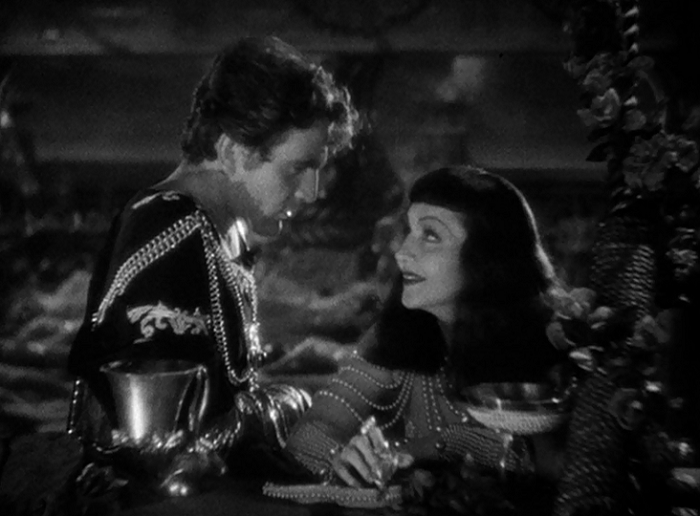
It’s hard not to be seduced by that smile.
She still likes the guy– her seduction of him, which includes a half naked woman writing on top of a bull, a net filled with barely clothed women, and a series of nymphs dressed as leopards jumping through flaming hoops is fantastic and almost puts the pageantry of Madam Satan to shame– but she knows better than to let him get too close. When she learns that Augustus has offered her the ability to spare Egypt by poisoning Antony, she’s in court working on something quick and painless in no time flat. Better to survive than suffer again at the hands of a foolish fair weather lover.
But her worst fears about Antony are unfounded, and upon learning about Augustus’ plans to invade and force Egypt to its knees, he plans a resistance. Defending her country is the same as defending her, and Cleopatra melts.
Spoilers (you know, if you don’t know history or anything).
Antony’s choice of course ostracizes him. His long time friend and companion, Enobarbus (C. Aubrey Smith), removes the honors they’ve won together and returns with Antony’s legions back to Rome. Still, Antony takes the underpowered armies of Egypt and heads to a confrontation at Actium.
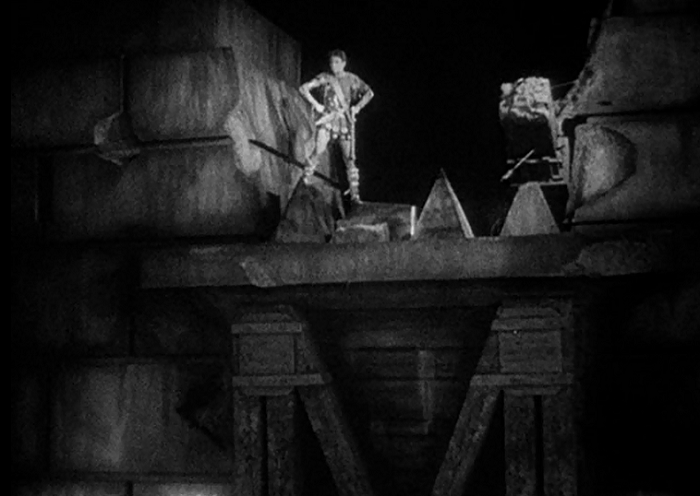
“Ya’ll better not be looking up my skirt.”
DeMille’s staging of the battles is fantastic, using montage and special effects to heighten the chaos. The cinematography carefully uses shadows and light to contrast some of the more violent escapades. Especially great are the moments where the special effects blatantly violate reality– a brief shot of one ship ramming another results in a shattered glass effect. Realistic, no, but it fits in with the devastating toll of the battle. Superimposition of Colbert and Wilcoxon’s wearied faces drive the devastation home.
This next part is going to sound weird, but stick with me. Wilcoxon’s scene on the walls of Alexandria may is about three details away from being one of the great scenes of film history. His uniform is tattered, the walls are crumbling, and still he challenges a strong, mighty army one-on-one if need be. His pride won’t quit. And as Augustus leads his troops in mocking and laughing at the exhausted Antony, it’s the perfect encapsulation of Roman hubris and cruelty.
Cleopatra raises the olive branch and tries to negotiate with Augustus. She’ll stop the doomed final confrontation if Augustus lets Antony live. Augustus laughs in her face. Antony, already distraught that Cleopatra would even consult the enemy, has already stabbed himself in the stomach; he dies in her arms. Facing conquest alone, Cleopatra does the only sensible thing by clasping an asp to her breast, dying on her throne.
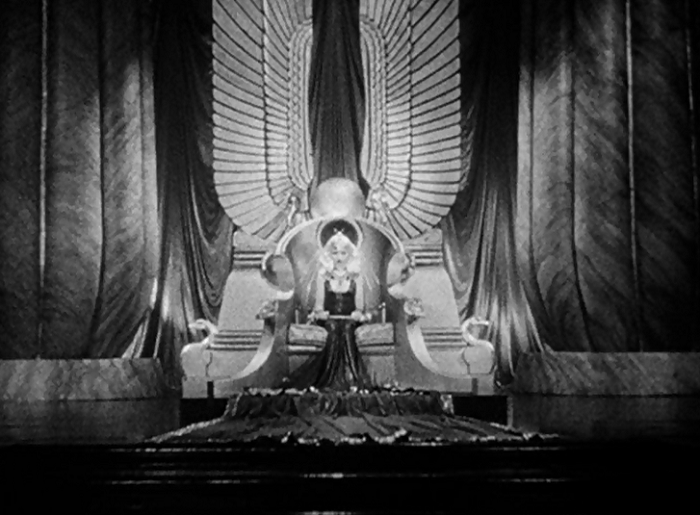
If you gotta, go out in style.
The Roman troops beat down the door and approach Cleopatra’s final resting place, still regal upon the throne. Their looks of confusion are perfect; the practical, bureaucratic conquerors don’t understand this manner of final, perfect resistance.
End spoilers.
DeMille’s Cleopatra is a hell of a movie, touching on issues of power, racism, and desire filtered through the lens of early 1930s film. The full bodied desire and pleasure that Colbert projects is sensual and chic, while her ability to reveal her more human side give her embodiment of Cleopatra as a fully developed legend. Her evolution, from the impish girl to the woman who died not for Egypt, but as Egypt, is what makes this movie so powerful.
Gallery
Hover over for controls.
Trivia & Links
- This film was actually released in October 1934, three months after the Production Code came into full effect. However, the film was still okayed by most church groups despite this, since DeMille’s grandiosity and ability to sell ‘historical’ as ‘classy’ gave him a bit more leeway.
- Believe it or not, the movie isn’t quite historically accurate. (And if you count that as a knock against the movie, get bent.) If you do want to learn more about the events surrounding Cleopatra’s life and that turbulent era, I recommend the History of Rome podcast. Here are the relevant episodes:
- Horrorview really hits Cleopatra on the head (the movie, I mean):
“Cleopatra” is thus a masterclass in cleverly evasive titillation, which emerged right on the cusp of the Hays Code clampdown; Demille pushes the risqué factor as far as he dare and ladles on the sumptuous Art Deco-themed sets and flamboyant but revealing costuming by Travis Banton (which often looks like some sort of gilded fetish gear), while emphasising the plot’s racier elements with images of bondage and a fervid atmosphere of decadent sexual intrigue.
- To help promote the film, a short film entitled The Hollywood You Never See was produced. It goes behind the scenes of the making of the film. My favorite part easily where DeMille brings out one of his own swords and starts smacking it all around.
- Worn Through talks about Colbert’s wardrobe throughout the film and its contentious creation– Colbert apparently wasn’t a big fan of her own hips, so she asked for the dresses to avert focus to her chest region, a task they certainly accomplished. It also has a few color pictures of one of her dresses, which is top notch.
- AMC Movie Site has a bunch of quotes and quite a thorough plot synopsis for this one, in case you thought I wasn’t cutting it.
- Cliff at Immortal Ephemera has a nice rundown of the film. He notes about Wilcoxon:
Henry Wilcoxon would next work in another Cecil B. DeMille film, The Crusades (1935) starring Loretta Young. Wilcoxon became associated with DeMille throughout the rest of his career, appearing in a number of titles for the legendary filmmaker and acting as associate producer on some of them as well. “I loved the old buzzard,” Wilcoxon said of DeMille (Eyman 306).
- Cliff at WarrenWilliam.com talks about William’s take on Caesar:
The authors of “Royal Portraits in Hollywood” assert that “DeMille takes this shortcut–Caesar as executive–to speed the story, exploiting the anticorporate prejudices of the time” (77). That might do for those who view the William characters as strict villains, but, no surprise, I liked Caesar’s style. Still, point taken. The same source in commenting upon the later scene in Caesar’s private room which ends in consummation of the Caesar and Cleopatra relationship aptly states that “He doesn’t caress or kiss her, and it takes a major suspension of disbelief to imagine that their walk up Cleopatra’s staircase, hands linked, ends in anything but a merger” (77).
- Here’s a trailer for the film’s reissue in the 1950s to cash in on some of DeMille’s further successes:
Awards, Accolades & Availability
- This film (quite understandably) appeared in the Wikipedia List of Pre-Code Films.
- Nominated for Best Picture of 1934, one of three Colbert films nominated that year. The other two are Imitation of Life and, the winner, It Happened One Night. This film did win an Oscar for Best Cinematography, and it’s not difficult to discern why.
- This film has had a number of DVD reissues in many different ways, which I assume comes from Universal trying to cash in on the many different reissues of the bigger, gaudier and incomprehensibly turgid 1963 Cleopatra with Elizabeth Taylor and Richard Burton. But, hey, that’s our gain. You can get 1934’s Cleopatra in The Cecil B. DeMille Set over on Amazon (which lacks any extras and is the version I saw), or on a solo disk. If you’re one of those damnable Brits, Masters of Cinema released a blu-ray version of this recently which looks fantastic and, hopefully, will get a release on this side of the pond too!
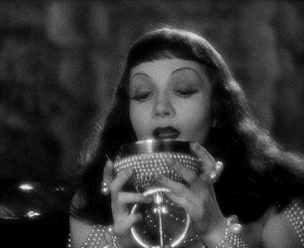 |
Comment below or join our email subscription list on the sidebar!Home | All of Our Reviews | What is Pre-Code? |
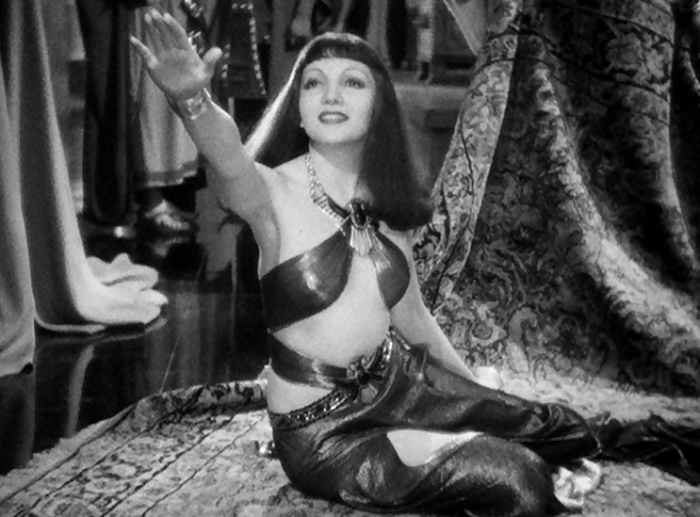

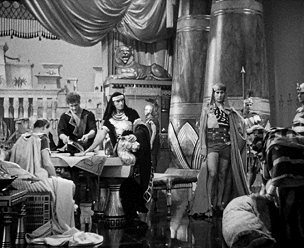



15 Comments
Vanessa B (@callmeveebee) · June 13, 2014 at 7:14 am
I watched this movie for the first time late last year and I REALLY enjoyed it! I honestly didn’t think I’d like it as much as I did but it was terrific; very entertaining and the cast was top-notch. I loved this post – great job!
Danny · June 16, 2014 at 11:29 pm
Thanks Vanessa. It’s one of those movies I didn’t go in expecting much and came out honestly very surprised. DeMille really hit on a lot of things I like about this era of film making, and I’m glad his spoke to others as well. Thanks for coming by!
Marsha Collock · June 16, 2014 at 12:46 am
FANtastic! Danny, I may not always leave a comment, but I simply adore your site – it is just awesome. Keep up the good work. As for Claudette as Cleo – she takes the role between her little French choppers and owns it,
Danny · June 16, 2014 at 11:31 pm
Thanks, Marsha, much appreciated! And I like the way you put that. Colbert does seem to have an intimidating mouth…
Swatopluk · August 3, 2014 at 6:09 pm
Ironically the historical Cleopatra was not raven haired but BLONDE. She was of the Macedonian family of Ptolemaios that did not mix with their Egyptian subjects (and practiced brother-sister marriage to keep the bloodline pure as was expected from the Pharaos by tradition). From the Roman point of view that did not make it any better though since Hellenist Greeks (as opposed to their heroic ancestors) were considered degenerate almost by definition. Rome was as Puritan (or Victorian) as one could get in the pre-Christian age and Augustus was the hypocrite-in-chief there.
Danny · August 7, 2014 at 11:54 am
Awesome! Thanks for the info, always love learning historical tidbits like this.
Ron Levine · September 7, 2014 at 11:01 am
What with the interminably dull and trivial credits putting people to sleep in modern films these days, mention has to be made of the astounding main and end title sequences in the movie, starting with the Egyptian eagle and slave girl holding the incense burners in the main title, and (what I believe to be) the closing of Cleopatra’s crypt in the end title sequence. DeMille shows his special touch from start to finish!
RonLev
Philly
Danny · September 8, 2014 at 12:00 am
Oh, I’m with you there. Cleopatra is a wondrous spectacle from start to finish. Great points, all!
shadowsandsatin · September 14, 2014 at 4:52 am
Great stuff, Danny. You’ve made me, for the first time, want to see this movie (I’m really not a huge Claudette Colbert fan, and this one just never really appealed to me). Now I simply have to get my hands on it.
Danny · October 8, 2014 at 6:30 pm
It’s a bunch of fun, Karen. I hope you check it out and enjoy!
Jepp D · January 14, 2016 at 3:20 am
Claudette was so smoking hot in Cleopatra it is a must see movie. If you watch her in her many movies she will definitely grow on you. She was beautiful and a great actress.
Danny · February 16, 2016 at 12:35 pm
Definitely. If you like her in Cleopatra, also check out Four Frightened People and I Cover the Waterfront.
Matt · February 10, 2016 at 2:42 pm
One of Wilcoxon’s very last roles was as the golf-obsessed Bishop Pickering in the 1980 comedy “Caddyshack”.
Lucius Vanini · June 27, 2016 at 12:24 pm
Colbert never looked better than in this one. And what a super-feminine, svelte form. As for the conjecture that the historical Cleopatra was not as “lily-white” as this Frenchwoman (Claudette WAS dragged up [to use Eugene O’Neill lingo] in Paris, vrai?), well, she certainly must’ve been tanned, living in Egypt as she did; but her ethnicity as a scion of the Ptolemy Dynasty was Macedonian, which is fully European. “Cleopatra” is not an Egyptian name but a Macedonian one, and I’ve read somewhere that she was a redhead.
Warren William is always interesting in my estimation, and it’s shocking that he is so little remembered today except by Pre-Code aficionados.
David Spalding · March 17, 2019 at 8:29 pm
I’ve heard that Cleopatra was released in October, 1934, but an August, 1934, issue of Variety indicates it was in release August 16. Perhaps a limited release in LA?
https://archive.org/stream/variety115-1934-08#page/n191/mode/2up
Comments are closed.